Sea fortress Svartholm
As a result of so called 'Hat's War' (Russian-Swedish conflict 1741-43) Sweden lost the western part of the so-called 'Old Finland' with fortresses Fredrikshamn (Hamina) and Vilmanstrand (Lappeenranta). All these things have been a pity, because the eastern border was left without protection. Therefore, in the 1747, the Riksdag decided to build a fortress at the new border with Russia in the village Degerby (future Loviisa) in order to block the 'Royal Road', and Svartholm sea fortress to protect its maritime flank .
In 1744 an engineer A. Nurdenberg made a reconnaissance of the area, and summer of 1747 colonels E.Liven and A.Ehrensvärd made a plan of the fortress and the following year construction work started. August Ehrensvärd the builder and creator of the famous fortress of Sveaborg (Suomenlinna) directed the works. The work was in full scale before the beginning of the 7-year war in 1755 and after that its intensity was significantly reduced, because lack of money. Ehrensvärd himself went to war in Pomerania.
After the war, in 1762 works were resumed, but were limited mainly to the repair of already built. By this time, all the bastions were finished, the Northern Tenaille was started, built cargo berth, a few wooden barracks, the powder magazine, the commandant's house, guardhouse were erected. Building of land fortifications on the mainland started in 1748, but by this time only two large bastions Ungern and Rosen were constructed.
During the Russian-Swedish War of 1789-90 Svartholm was used as the base for the Swedish Archipelago fleet, which was established in 1756 at the suggestion of August Ehrensvärd.
Turing Finnish war of 1808-9 Russian troops seized the Loviisa town and besieged Svartholm fortress. After the two-week blockade and bombardment of the fortress, its commandant Colonel Carl Grippenberg surrendered the fortifications. It was March 6, 1808. Rumors circulated about the change that Svartholm had no food and ammunition supply.
Svartholm had no value for the Russian authorities as a fortress, so from 1809 to 1847 it was used as a prison. In 1826 its prisoners were Decembrists - participants of 1824 mutiny in St.Petersburg. There was a small team of artillery and sapper detachment also.
Hard time had Svartholm during the Crimean (Eastern) War 1853-56. Allies cruised around the Baltic Sea, devastating coastal Russian fortress, harbors and naval bases and strongholds. July 4, 1855 British sailors disembarked from the ships of captain Elverton on the island of and blew up the central part of the fortress.
After the Crimean (Eastern) War the fortress ruins become as a source of building materials (bricks) for the fast-growing town of Loviisa, while in 1911 he was visited by the commission for the protection of monuments. By the time, the island was used as pasture, and the sad ruins overgrown with grass and bushes.
The first excavations and restoration work in Svartholm began in 1937 on the initiative of the city authorities of Loviisa. Second World War stopped all works, but in 1968, under the direction of architect E.Vormala more extensive cleaning and restoration works began. Ramparts were restored, awnings were built, the second floor of the North Curtain where is now a museum of the fortress was constructed.
In 1994 began the next, and probably not the last stage of work, during which old Swedish pier was restored, new protective canopies were built and all the interiors were cleared. In 1998 the 250th anniversary of the founding of the fortress was celebrated. To this anniversary date of the restoration of the main strengthening of Svartholm was completed.
Impressions
Cozy and nice fortress, I would say. Nice place for a hot summer weekend. Especially with kids. An excellent example of using of old ruins as a place for rest and education.
Land forts and fortress:
Bip Castle Gatchina Ivangorod Izborsk Kexholm Kirillov Monastery Koporye Novgorod Pechorskiy Monastery Peter&Paul Fortress Porkhov Pskov Schlisselburg Staraya Ladoga Tikhvin Vyborg Hameenlinna Hamina Kastelholm Kymenlinna Lappaenranta Raseborg Castle Savonlinna Tavetti Turku Visby Fredrikstadt Fredriksten Hegra Fort Hoytorp Fort Arensburg Narva Tallinn Antipatris Caesarea Jerusalem Latrun Fort Masada
Sea forts and fortresses:
Alexander Fort Ino Fort Krasnaya Gorka Fort Kronstadt: Kotlin isl. Kronstadt: North Forts Kronstadt: South Forts Trongsund Hanko Svartholm Sveaborg Marstrand Siaro Fort Vaxholm Oscarsborg
Artillery batteries and individual guns:
Coastal Artillery Hemso Fort
Fortified areas and defensive lines:
Karelian Fortified Area (KaUR) KrUR Leningrad Mannerheim Line Nevsky Bridgehead VT Line Harparskog Line Salpa Line Gothland
Russian
S e a r c h All news

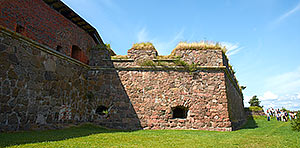
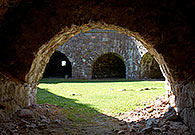 Bastions of Svartholm Fortress
Bastions of Svartholm Fortress
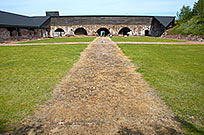 Central courtyard of Svartholm fortress
Central courtyard of Svartholm fortress
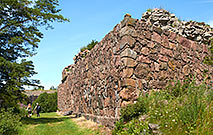 Astions of the Degerby fortress in Loviisa
Astions of the Degerby fortress in Loviisa
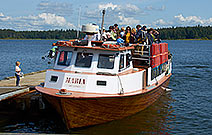 Loviisa-Svartholm ferry at the fortress pier
Loviisa-Svartholm ferry at the fortress pier
